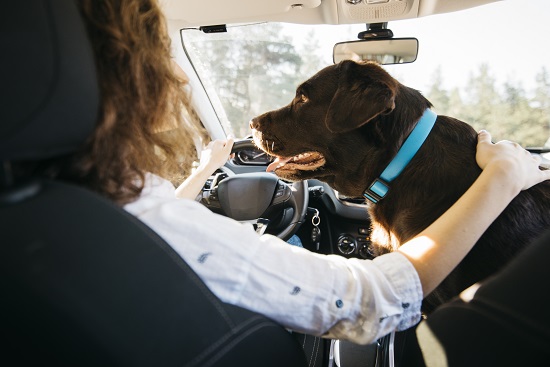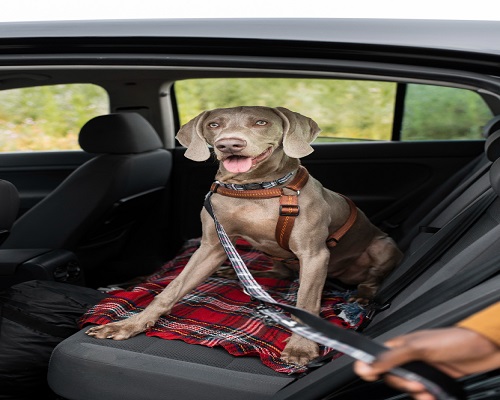When it comes to traveling with our furry companions, the safety and well-being of our beloved pets should always be a top priority. One crucial aspect of ensuring their safety is knowing how to secure your dog in the car with a leash. In this comprehensive guide, we will explore various methods and best practices for keeping your canine friend safe and secure during car rides. Whether you’re embarking on a road trip or simply taking a short drive to the vet, implementing these strategies will give you peace of mind and protect your dog from potential harm. So, let’s dive in and discover the best ways to keep your dog secure in the car!
Table of Contents
- Understanding the Importance of Securing Your Dog in the Car
- Selecting the Right Leash for Car Travel
- Properly Harnessing Your Dog in the Car
- Utilizing Dog Seat Belts for Added Safety
- Creating a Comfortable and Secure Space for Your Dog
- Ensuring Proper Ventilation and Temperature Control
- Planning for Frequent Breaks and Hydration
- Introducing Your Dog to Car Travel: Training Tips
- Common Mistakes to Avoid When Securing Your Dog in the Car
- Traveling with Multiple Dogs: Challenges and Solutions
- Tips for Long-Distance Travel with Your Dog
- Adhering to Local Laws and Regulations
- Frequently Asked Questions (FAQs)
Understanding the Importance of Securing Your Dog in the Car

Securing your dog in the car is vital for several reasons. Firstly, it prevents your dog from distracting the driver, which could lead to accidents. Secondly, in the unfortunate event of a sudden stop or collision, an unrestrained dog can become a dangerous projectile, risking severe injuries to both the dog and the passengers. Additionally, securing your dog ensures they stay safely inside the vehicle, reducing the risk of them escaping or getting lost in unfamiliar surroundings. By taking the necessary precautions and using a leash or harness, you can protect your dog and provide them with a comfortable travel experience.
Selecting the Right Leash for Car Travel
When it comes to selecting a leash for car travel, there are a few key factors to consider. First and foremost, choose a leash that is sturdy and durable, capable of withstanding the forces that may occur during sudden stops or sharp turns. Look for materials such as nylon or reinforced webbing, as they offer strength and durability. Furthermore, opt for a leash with an appropriate length, allowing your dog to move comfortably without getting tangled or creating potential hazards. Consider a leash with an adjustable feature, as it allows you to customize the length based on your dog’s size and the available space in your vehicle.
Properly Harnessing Your Dog in the Car
A harness is an excellent tool for securing your dog in the car. Unlike a collar, which can put strain on the neck and throat during sudden movements, a harness distributes the force evenly across your dog’s chest and back. This helps to prevent injuries and ensures greater comfort for your furry friend. When choosing a harness, make sure it fits properly and provides a snug but not restrictive fit. Adjust the straps accordingly to avoid any potential discomfort. It’s also essential to familiarize your dog with wearing the harness before embarking on a car journey, as this will help them feel more at ease during travel.
Utilizing Dog Seat Belts for Added Safety
Dog seat belts are another valuable tool for securing your canine companion during car rides. Similar to seat belts for humans, these specially designed restraints attach to your dog’s harness and connect to the vehicle’s seat belt buckle. This setup ensures that your dog remains safely in place, preventing them from moving around excessively or becoming a hazard. When purchasing a dog seat belt, ensure that it is crash-tested and meets the necessary safety standards. Follow the manufacturer’s instructions for proper installation, and regularly inspect the seat belt for any signs of wear or damage.
Creating a Comfortable and Secure Space for Your Dog


To enhance your dog’s comfort and security during car travel, it’s essential to create a designated space specifically for them. This can be achieved by utilizing a dog crate or a travel carrier that is appropriately sized for your dog. The crate or carrier should be well-ventilated and provide enough room for your dog to stand, sit, lie down, and turn around comfortably. Line the bottom of the crate or carrier with a soft and non-slip mat to ensure your dog’s stability during the journey. Familiarize your dog with the crate or carrier beforehand, gradually introducing them to it and associating it with positive experiences.
Also Read: How to get rid of dog hair in car
Ensuring Proper Ventilation and Temperature Control
Maintaining a suitable temperature and ensuring proper ventilation is crucial for your dog’s well-being during car rides. Dogs are susceptible to heat exhaustion and heatstroke, especially in hot weather or when confined in a small space. Avoid leaving your dog alone in a parked car, as temperatures can rise rapidly, even with the windows cracked. If air conditioning is available, set it to a comfortable temperature to keep your dog cool. In the absence of air conditioning, ensure proper air circulation by partially opening windows or using a fan. Always prioritize your dog’s comfort and monitor them closely for any signs of distress.
Planning for Frequent Breaks and Hydration
Just like humans, dogs require regular breaks and access to water during long car journeys. Plan your travel route in a way that allows for frequent stops, giving your dog an opportunity to stretch their legs, relieve themselves, and hydrate. When taking breaks, choose safe and designated areas where your dog can walk and explore without the risk of escaping or encountering hazards. Carry an adequate supply of fresh water and a portable water bowl to ensure your dog remains hydrated throughout the trip. Remember, keeping your dog well-hydrated is essential for their overall comfort and health.
Introducing Your Dog to Car Travel: Training Tips
For some dogs, car travel can be a stressful experience. However, with proper training and positive reinforcement, you can help your dog overcome any anxiety or fear associated with car rides. Gradually introduce your dog to the car environment by allowing them to explore the vehicle while it is stationary. Associate the car with positive experiences by offering treats, praise, and their favorite toys inside the car. Start with short trips to familiar places, gradually increasing the duration and distance as your dog becomes more comfortable. Patience, consistency, and a calm demeanor will go a long way in helping your dog enjoy car travel.
Common Mistakes to Avoid When Securing Your Dog in the Car
While it’s important to know the best practices for securing your dog in the car, it’s equally essential to be aware of common mistakes to avoid. One common mistake is allowing your dog to sit on your lap or roam freely inside the car. This not only poses a safety risk but also increases the chances of driver distraction. Another mistake is attaching the leash or harness to your dog’s collar instead of a harness. This can lead to neck injuries and discomfort for your dog during sudden movements. Additionally, leaving your dog unattended in the car, especially in extreme weather conditions, is extremely dangerous and should be avoided at all costs.
Traveling with Multiple Dogs: Challenges and Solutions
If you have multiple dogs, ensuring their safety and security in the car presents additional challenges. It’s crucial to provide each dog with their designated space to avoid potential conflicts and distractions. Consider using individual crates or travel carriers for each dog, ensuring that they are securely fastened and positioned to prevent movement. Introduce the concept of car travel to each dog individually, gradually acclimating them to the experience. During the journey, monitor their interactions closely and address any signs of stress or tension. By prioritizing each dog’s comfort and safety, you can successfully travel with multiple dogs.
Tips for Long-Distance Travel with Your Dog


Long-distance travel requires careful planning and preparation to ensure your dog’s well-being throughout the journey. Start by scheduling a visit to the veterinarian for a health check-up and to ensure that your dog is up to date on vaccinations. Pack a travel kit that includes essentials such as food, water, medications (if applicable), leash, harness, waste bags, and their favorite comfort items. Plan your route with frequent breaks and research pet-friendly accommodations along the way. Prioritize your dog’s comfort and make adjustments as necessary based on their needs. Lastly, be observant of any signs of discomfort or illness during the trip and seek veterinary care if needed.
Adhering to Local Laws and Regulations
When traveling with your dog in the car, it’s essential to familiarize yourself with local laws and regulations regarding pet transportation. Different regions may have specific requirements, such as restraining dogs with seat belts or harnesses. Research the laws of your destination and any states or countries you will be passing through. Compliance with these regulations not only ensures your dog’s safety but also helps avoid any potential fines or penalties. Stay informed and be a responsible pet owner by adhering to the laws and regulations in place.
Frequently Asked Questions (FAQs)
Q: Can I secure my dog with just a leash in the car? A: While a leash can provide some level of restraint, it is not recommended as the sole method of securing your dog in the car. Using a properly fitted harness or a dog seat belt, in combination with a leash, offers better safety and prevents unnecessary strain on your dog’s neck.
Q: Should I leave my dog unrestrained in the car during short stops? A: No, it is not advisable to leave your dog unrestrained in the car, even during short stops. Dogs can easily become anxious, attempt to escape, or experience temperature-related issues. Always secure your dog or bring them with you when making any stops.
Q: How can I help my dog overcome car anxiety? A: To help your dog overcome car anxiety, gradually introduce them to the car environment, associate positive experiences, and provide comfort and reassurance. Consulting with a professional dog trainer or behaviorist may also be beneficial in addressing car anxiety.
Q: Are there any breeds that require special considerations during car travel? A: Some breeds, especially brachycephalic breeds (dogs with short muzzles), may be more prone to respiratory difficulties and heat sensitivity. It’s important to consult with your veterinarian and take extra precautions, such as providing additional ventilation and avoiding excessive heat exposure.
Q: Can I secure my dog in the car using a crate or carrier? A: Yes, utilizing a crate or carrier is an effective method of securing your dog in the car. Make sure the crate or carrier is appropriately sized, well-ventilated, and securely fastened to prevent movement or tipping during travel.
Conclusion
Securing your dog in the car with a leash is a crucial step in ensuring their safety and well-being during car rides. By selecting the right leash, harnessing your dog properly, utilizing seat belts, and creating a comfortable space, you can provide a secure environment for your furry friend. Remember to plan for frequent breaks, prioritize hydration, and train your dog to enjoy car travel. Avoid common mistakes and adhere to local laws and regulations to promote a safe and enjoyable journey for both you and your canine companion. With these comprehensive guidelines, you can confidently embark on your car adventures, knowing that your dog is secure and protected every step of the way.

